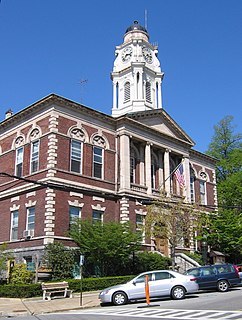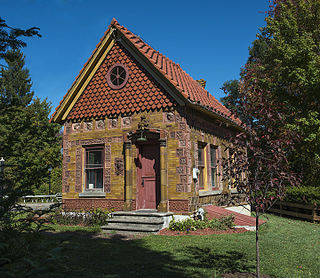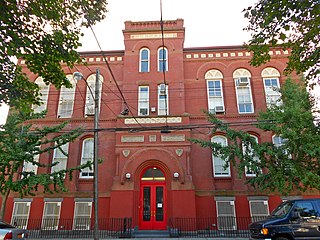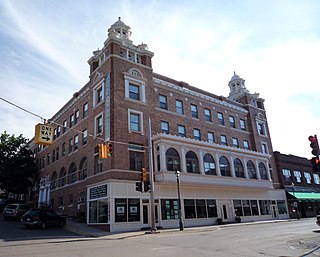
The Merchants Building is a commercial building located at 206 East Grand River Avenue in Downtown Detroit, Michigan. It is also known as the Broadway Merchants Building. It was listed on the National Register of Historic Places in 1983.

The Belcrest Apartments is an apartment building located at 5440 Cass Avenue in Midtown Detroit, Michigan. It was built in 1926 as the Belcrest Hotel, designated a Michigan State Historic Site in 1983, and listed on the National Register of Historic Places in 1984. It is significant as an early example of the apartment hotel development concept in Detroit, and a major early work of architect Charles N. Agree.

Irvington Town Hall is located on Main Street in the village of Irvington in the U.S. state of New York. In addition to being home to the village government, police department, and until 2000 the public library, it has a public reading room in keeping with the requirements of the original land deed. A 432-seat theatre, used for many local gatherings such as school graduations, was also built on the second story.

St. Cecilia Church is a Roman Catholic parish church in the Roman Catholic Archdiocese of New York and a historic landmark located at 120 East 106th Street between Park Avenue and Lexington Avenue, Manhattan, New York City, New York. The parish was established in 1873. It was staffed by the Redemptorist Fathers from 1939-2007. The church was designated a New York City landmark in 1976. The church and convent were listed on the U.S. National Register of Historic Places in 1984.

Terra Cotta Building is a historic office building and display center located at Alfred in Allegany County, New York. It was built in 1892 by the Celadon Terra Cotta Co and later sold in 1906, to the Ludowici Company of Ohio, which became the Ludowici-Celadon Company. It is a one-story, 16-foot-wide (4.9 m), 25-foot-deep (7.6 m) building built almost entirely of terra cotta bricks, ornamental and roofing tiles manufactured by Celadon. The building was designed as a sales office for the company, and was considered a "catalog" of their work. A replica was erected at the 1893 Columbian Exposition in Chicago. The building was the only remaining structure after a fire broke out on August 29, 1909 and destroyed what was at the time called Ludowici-Celadon Company.

First Presbyterian Church is a historic Presbyterian church located at Dundee in Yates County, New York. It is a Romanesque style brick structure, with limestone and terra cotta trim, built in 1895. It is distinguished by two multi-story towers, broad cross gables, bold, turret-like pinnacles and finials, and finely crafted corbelled brock trim.

Sheldon Hall is a historic collegiate building located on the campus of the State University of New York at Oswego at Oswego in Oswego County, New York.

The New York Evening Post Building, also known as the New York Post Building or the Post Towers, is a historic commercial building located in Lower Manhattan, New York City, New York. The building was designed by architect Horace Trumbauer and built in 1926.

The United States Post Office Canal Street Station, originally known as "Station B", is a historic post office building located at 350 Canal Street at the corner of Church Street in the Tribeca neighborhood of Manhattan, New York City. It was built in 1937, and designed by consulting architect Alan Balch Mills for the Office of the Supervising Architect of the United States Department of the Treasury.

The Pines is a historic home located at the hamlet of Pine Plains in the town of Pine Plains, Dutchess County, New York. It was built in 1878 and is a large 2-story frame residence with a 1 1⁄2-story service wing designed in the Stick-Eastlake style. It has an asymmetrical appearance with projecting bays, cross gables, and porches. It features a steeply pitched, common lap slate roof, four corbeled chimney stacks with terra cotta pots, and a tower with a steeply pitched pyramidal roof.

The Bar Building is a historic commercial building designed by architect Benjamin Levitan and located at White Plains, Westchester County, New York.

Renaissance Apartments is a historic apartment building located at Hancock Street and Nostrand Avenue in Bedford-Stuyvesant, Brooklyn, New York City. It was built in 1892 and is a five-story masonry building in the French Renaissance style. It features elaborately decorated principal facades and prominent circular corner towers with slate covered conical roofs. It has steeply sloped slate mansard roofs with terra cotta ridge caps and gabled roof dormers.

Public School 65K is a historic school building located in Cypress Hills, Brooklyn, New York, New York. It was originally built in 1870 and significantly expanded in 1889 to designs by James W. Naughton. It is a two-story, brick building on a stone base in the Romanesque Revival style. It features a slightly projecting central tower and terra cotta decorative details.

The Douglass House is a hotel located at the corner of Sheldon Avenue and Isle Royale Street in Houghton, Michigan. It was placed on the National Register of Historic Places in 1982.

The Dyckman-Hillside Substation, also known as Substation 17, is a historic electrical substation located at 127-129 Hillside Avenue between Sickles Street and Nagle Avenue, near the Dyckman Street station of the New York City Subway's IRT Broadway–Seventh Avenue Line, in Inwood, Manhattan, New York City. It was one of eight substations constructed by the Interborough Rapid Transit Company in 1904–05.

Hotel Warwick is a historic hotel building located at Newport News, Virginia. It was built in 1928, and is a seven-story, brick building in an eclectic Gothic Revival / Art Deco style. It features terra cotta tile ornamentation and a continuous terra cotta and brick false parapet. A two-story addition was added to the rear of the building in 1962. It was the first skyscraper, first tower hotel and first fireproof hotel in Newport News. It replaced an earlier Hotel Warwick built by Collis Potter Huntington in 1883.

St. Matthias Roman Catholic Church Complex is a historic Roman Catholic church complex located in the Ridgewood neighborhood of Queens County, New York. The church was built in 1926, and is an Italian Renaissance Revival style, brick, stone, and terra cotta church with a gable roof. It features a three-stage bell tower at the projecting center bay and Corinthian order columns. Also on the property are the contributing four-story rectory (1910), school, and convent (1914).

116 John Street is a historic office tower at the southwest corner of John Street and Pearl Street in the Financial District of Lower Manhattan in New York City. It was built in 1931, and is a 35-story brick and terra cotta building consisting of a three-story base, a 19-story shaft, and 12 upper stories that recede in a series of setbacks. The building features Art Deco style design elements at the recessed entrances and in the lobby. Built as a speculative office building for insurance companies, the building interior was rehabilitated in 2013 and some floors converted to apartments.

Indianapolis News Building, also known as the Goodman Jewelers Building, is a historic commercial building located at Indianapolis, Indiana. It was designed by architect Jarvis Hunt (1863–1941) and built in 1909–1910. It is a ten-story, rectangular, Neo-Gothic style brick and terra cotta building. It is three bays wide and 10 bays deep. The top floor features a corbelled terra cotta balcony, Tudor-like window openings, and a Gothic parapet. It is located next to the Taylor Carpet Company Building. The building housed the Indianapolis News until 1949.

Selig's Dry Goods Company Building, also known as Morrisons/Em-roe Sporting Goods Company, is a historic commercial building located at Indianapolis, Indiana. It was built in 1924, and is a seven-story, rectangular, Beaux-Arts style building with a white terra cotta and aluminum front facade. It was remodeled in 1933. The building features tinted plate glass windows and a terra cotta Roman thermal window-like screen at the top floor. The building housed the Selig's Dry Goods Company, in operation until 1933.























